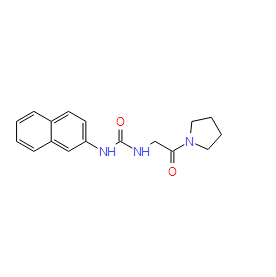| Cas No.: | 1624117-53-8 |
| Chemical Name: | N-2-Naphthalenyl-N'-[2-oxo-2-(1-pyrrolidinyl)ethyl]urea |
| Synonyms: | XY1,XY-1,XY 1 |
| SMILES: | N(C1=CC=C2C(=C1)C=CC=C2)C(NCC(=O)N1CCCC1)=O |
| Formula: | C17H19N3O2 |
| M.Wt: | 297.35 |
| Purity: | >98% |
| Sotrage: | 2 years -20°C Powder, 2 weeks 4°C in DMSO, 6 months -80°C in DMSO |
| Description: | XY1 is a very close analogue of SGC707 (a potent, selective, and non-competitive inhibitor of PRMT3 with IC50 of 31 nM), but XY1 is completely inactive.XY1 is a close analogue of SGC707, is completely inactive againstPRMT3 at concentrations as high as 100 μM. XY1 contains a naphthyl group replacing the isoquinoline group, lacks the key hydrogen bond with T466. The naphthyl ring of XY1 could act as a weak hydrogen-bond acceptor, but this should come with a substantial enthalpic penalty. The more than 1000-fold potency loss of XY1 compared with SGC707 supports this analysis. It is unclear whether other factors such as electronic effects also contributed to the potency loss of XY1 compared with SGC707. SGC707 and XY1 are a pair of excellent tools for the biomedical community to further elucidate biological functions and disease associations of PRMT3. |
| Target: | PRMT3 |
| References: | [1]. Kaniskan H?, et al. A potent, selective and cell-active allosteric inhibitor of protein arginine methyltransferase 3 (PRMT3). Angew Chem Int Ed Engl. 2015 Apr 20;54(17):5166-70. |

 DC Chemicals' products qualify for U.S. tariff exemptions. We guarantee no price increases due to customs duties and maintain stable supply, continuing to deliver reliable research solutions to our American clients.
DC Chemicals' products qualify for U.S. tariff exemptions. We guarantee no price increases due to customs duties and maintain stable supply, continuing to deliver reliable research solutions to our American clients.





















